Toilet paper
Toilet paper (sometimes called toilet roll,[1] toilet tissue[2] or loo roll[3] in Britain) is a tissue paper product primarily used to clean the anus and surrounding area of feces after defecation and to clean the perineal area of urine after urination or other bodily fluid releases. It also acts as a layer of protection for the hands during these processes. It is usually supplied as a long strip of perforated paper wrapped around a paperboard core for storage in a dispenser near a toilet. Most modern toilet paper in the developed world is designed to decompose in septic tanks, whereas some other bathroom and facial tissues are not. Toilet paper comes in various numbers of plies (layers of thickness), from one- to six-ply, with more back-to-back plies providing greater strength and absorbency.
.jpg)
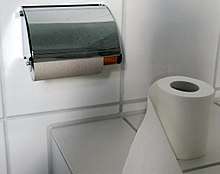
The use of paper for hygiene has been recorded in China in the 6th century AD, with specifically manufactured toilet paper being mass-produced in the 14th century.[4] Modern commercial toilet paper originated in the 19th century, with a patent for roll-based dispensers being made in 1883.
History
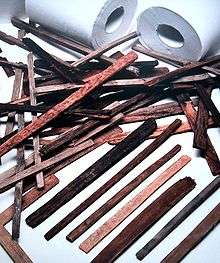
Although paper had been known as a wrapping and padding material in China since the 2nd century BC,[5] the first documented use of toilet paper in human history dates back to the 6th century AD, in early medieval China.[4] In 589 AD the scholar-official Yan Zhitui (531–591) wrote about the use of toilet paper:
Paper on which there are quotations or commentaries from the Five Classics or the names of sages, I dare not use for toilet purposes.[4]
During the later Tang dynasty (618–907 AD), an Arab traveller to China in the year 851 AD remarked:
...they [the Chinese] do not wash themselves with water when they have done their necessities; but they only wipe themselves with paper.[4]
During the early 14th century, it was recorded that in what is now Zhejiang alone, ten million packages of 1,000 to 10,000 sheets of toilet paper were manufactured annually.[4] During the Ming dynasty (1368–1644 AD), it was recorded in 1393 that an annual supply of 720,000 sheets of toilet paper (approximately 2 by 3 ft (60 by 90 cm)) were produced for the general use of the imperial court at the capital of Nanjing.[4] From the records of the Imperial Bureau of Supplies of that same year, it was also recorded that for the Hongwu Emperor's imperial family alone, there were 15,000 sheets of special soft-fabric toilet paper made, and each sheet of toilet paper was perfumed.[4]
Elsewhere, wealthy people wiped themselves with wool, lace or hemp, while less wealthy people used their hand when defecating into rivers, or cleaned themselves with various materials such as rags, wood shavings, leaves, grass, hay, stones, sand, moss, water, snow, ferns, plant husks, fruit skins, seashells, or corncobs, depending upon the country and weather conditions or social customs. In Ancient Rome, a sponge on a stick[6] was commonly used, and, after use, placed back in a pail of vinegar. Several talmudic sources indicating ancient Jewish practice refer to the use of small pebbles, often carried in a special bag, and also to the use of dry grass and of the smooth edges of broken pottery jugs (e.g., Shabbat 81a, 82a, Yevamot 59b). These are all cited in the classic Biblical and Talmudic Medicine by the German physician Julius Preuss (Eng. trans. Sanhedrin Press, 1978).
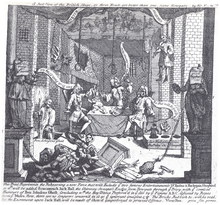
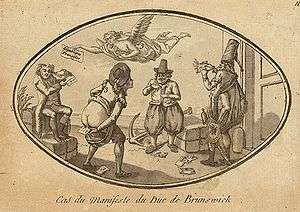
The 16th-century French satirical writer François Rabelais, in Chapter XIII of Book 1 of his novel sequence Gargantua and Pantagruel, has his character Gargantua investigate a great number of ways of cleansing oneself after defecating. Gargantua dismisses the use of paper as ineffective, rhyming that: "Who his foul tail with paper wipes, Shall at his ballocks leave some chips." (Sir Thomas Urquhart's 1653 English translation). He concludes that "the neck of a goose, that is well downed" provides an optimum cleansing medium.[7]
The rise of publishing by the eighteenth century led to the use of newspapers and cheap editions of popular books for cleansing. Lord Chesterfield, in a letter to his son in 1747, told of a man who purchased
a common edition of Horace, of which he tore off gradually a couple of pages, carried them with him to that necessary place, read them first, and then sent them down as a sacrifice to Cloacina; thus was so much time fairly gained ....[8]
In many parts of the world, especially where toilet paper or the necessary plumbing for disposal may be unavailable or unaffordable, toilet paper is not used. Also, in many parts of the world people consider using water a much cleaner and more sanitary practice than using paper.[9] Cleansing is then performed with other methods or materials, such as water, for example using a bidet, a lota, rags, sand, leaves (including seaweed), corn cobs, animal furs, sticks or hands; afterwards, hands are washed with water and possibly soap.
As a commodity
Joseph Gayetty is widely credited with being the inventor of modern commercially available toilet paper in the United States. Gayetty's paper, first introduced in 1857, was available as late as the 1920s. Gayetty's Medicated Paper was sold in packages of flat sheets, watermarked with the inventor's name. Original advertisements for the product used the tagline "The greatest necessity of the age! Gayetty's medicated paper for the water-closet."
Seth Wheeler of Albany, New York, obtained the earliest United States patents for toilet paper and dispensers, the types of which eventually were in common use in that country, in 1883.[10] Toilet paper dispensed from rolls was popularized when the Scott Paper Company began marketing it in 1890.[11]
The manufacturing of this product had a long period of refinement, considering that as late as the 1930s, a selling point of the Northern Tissue company was that their toilet paper was "splinter free".[12] The widespread adoption of the flush toilet increased the use of toilet paper, as heavier paper was more prone to clogging the trap that prevents sewer gases from escaping through the toilet.[13]
Softer, two ply toilet roll was introduced in Britain in 1942, by St Andrew Mills in Walthamstow; this became the famous Andrex.[14]
Moist toilet paper, called wet wipes, was first introduced in the United Kingdom by Andrex in the 1990s. It has been promoted as being a better method of cleaning than dry toilet paper after defecation, and may be useful for women during menstruation. It was promoted as a flushable product but it has been implicated in the creation of fatbergs; by 2016 some municipalities had begun education campaigns advising people not to flush used wet wipes.[15]
More than seven billion rolls of toilet paper are sold yearly in the United States. Americans use an average of 23.6 rolls per capita per year.[16]
| External video | |
|---|---|
In 1973, Johnny Carson joked in his Tonight Show monologue about comments made by Wisconsin congressman Harold V. Froehlich about the possibility of a toilet paper shortage. Subsequently, consumers purchased abnormal amounts, causing an actual shortage in the United States for several months.[17][18]
Toilet paper has been one of the commodities subject to shortages in Venezuela starting in the 2010s; the government seized one toilet paper factory in a failed effort to resolve the problem.[19]
During the COVID-19 pandemic, toilet paper shortages were reported in March 2020 in a number of countries due to excessive hoarding and panic buying.[20][21][22][23][24] Unlike other products, toilet paper has no substitute. At first, few believed the pandemic would be serious. Later, people realized they might need to stock up on certain items in case of a shelter-in-place order, or in case they did not know how long such an order would last; suppliers could not assure that they could keep up with demand.[25][26] However, manufacturers continued to produce even more than they had before. Demand was higher for the types of toilet paper used at home because so many people were at home who would have used toilet paper away from home.[27] In countries other than the United States, the bidet was already seen as a solution, and a survey before the pandemic had indicated an increasing number of Americans would be interested.[28]
Description
Toilet paper is available in several types of paper, a variety of patterns, decorations, and textures, and it may be moistened or perfumed, although fragrances sometimes cause problems for users who are allergic to perfumes. The average measures of a modern roll of toilet paper is c. 10 cm (315/16 in.) wide, and 12 cm (423/32 in.) in diameter, and weighs about 227 grams (8 oz.).[29] An alternative method of packing the sheets uses interleaved sheets in boxes, or in bulk for use in dispensers. "Hard" single-ply paper has been used as well as soft multi-ply.
Size
Manufactured toilet paper sheet in the United States was sized 4.5 in (11 cm) × 4 in (10 cm).[30] Since 1999 the size of a sheet has been shrinking; Kimberly-Clark reduced the length of a sheet to 4.1 in (10 cm).[31] Scott, in 2006, reduced the length of their product to 3.7 in (9.4 cm). The width of sheets was later reduced giving a general sheet size of 3.7 in (9.4 cm) long and 4.1 in (10 cm) wide. Larger sizes remain available.
Materials
Toilet paper products vary greatly in the distinguishing technical factors, such as size, weight, roughness, softness, chemical residues, "finger-breakthrough" resistance, water-absorption, etc. The larger companies have very detailed, scientific market surveys to determine which marketing sectors require or demand which of the many technical qualities. Modern toilet paper may have a light coating of aloe or lotion or wax worked into the paper to reduce roughness.
Quality is usually determined by the number of plies (stacked sheets), coarseness, and durability. Low grade institutional toilet paper is typically of the lowest grade of paper, has only one or two plies, is very coarse and sometimes contains small amounts of embedded unbleached/unpulped paper.[32] A brand disinfected with Carbolic Acid was manufactured in Sheffield under the Izal brand name by Newton Chambers until 1981.[33] Mid-grade two ply is somewhat textured to provide some softness and is somewhat stronger. Premium toilet paper may have lotion and wax and has two to four plies of very finely pulped paper. If it is marketed as "luxury", it may be quilted or rippled (embossed), perfumed, colored or patterned, medicated (with anti-bacterial chemicals), or treated with aloe or other perfumes.
To advance decomposition of the paper in septic tanks or drainage, the paper used has shorter fibres than facial tissue or writing paper. The manufacturer tries to reach an optimal balance between rapid decomposition (which requires shorter fibres) and sturdiness (which requires longer fibres). Compaction of toilet paper in drain lines, such as in a clog, prevents fibre dispersion and largely halts the breakdown process.
A German quip says that the toilet paper of Nazi Germany was so rough and scratchy that it was almost unusable, so many people used old issues of the Völkischer Beobachter instead, because the paper was softer.[34]
Color and design
Colored toilet paper in colors such as pink, lavender, light blue, light green, purple, green, and light yellow (so that one could choose a color of toilet paper that matched or complemented the color of one's bathroom) was commonly sold in the United States from the 1960s. Up until 2004, Scott was one of the last remaining U.S. manufacturers to still produce toilet paper in beige, blue, and pink. However, the company has since cut production of colored paper altogether.[35]
Today, in the United States, plain unpatterned colored toilet paper has been mostly replaced by patterned toilet paper, normally white, with embossed decorative patterns or designs in various colors and different sizes depending on the brand. Colored toilet paper remains commonly available in some European countries.
Installation
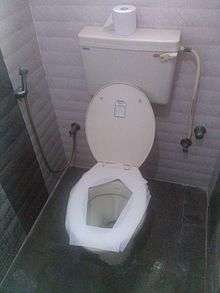
Dispensers
A toilet roll holder, also known as a toilet paper dispenser, is an item that holds a roll of toilet paper. There are at least seven types of holders:
- A horizontal piece of wire mounted on a hinge, hanging from a door or wall.
- A horizontal axle recessed in the wall.
- A vertical axle recessed in the wall
- A horizontal axle mounted on a freestanding frame.
- A freestanding vertical pole on a base.
- A wall mounted dispensing unit, usually containing more than one roll. This is used in the commercial/away-from-home marketplace.
- A wall mounted dispensing unit with tissue interleaved in a "S"-type fold so the user can extract the tissue one sheet at a time.
Some commercial or institutional toilet paper is wrapped around a cylinder to many times the thickness of a standard toilet paper roll.
Orientation
There are two choices of orientation when using a holder with a horizontal axle parallel to the wall: the toilet paper may hang over or under the roll. The choice is largely a matter of personal preference, dictated by habit. In surveys of American consumers and of bath and kitchen specialists, 60–70% of respondents prefer over. This is said to exhibit Endianness, which applies not only to eggs, but to toilet paper. Most Americans think it should go over the top, like a waterfall.[36]
Decoration
Toilegami refers to toilet paper origami. Like table napkins, some fancy Japanese hotels fold the first squares of toilet paper on its dispenser to be presented in a fashionable way.[37]
Recreational use
In the United States, toilet paper has been the primary tool in a prank known as "TP-ing" (pronounced "teepeeing"). TP-ing, or "toilet papering", is often favored by adolescents and is the act of throwing rolls of toilet paper over cars, trees, houses and gardens, causing the toilet paper to unfurl and cover the property, creating an inconvenient mess.[38]
Children and cats may unroll an entire roll of toilet paper by spinning it until it completely unravels on the floor, or as a game by children wadding up one end, putting it in the toilet bowl without tearing it and then using the flushing of the toilet to pull new paper into the toilet, with the objective of flushing the entire roll down the toilet section at a time without the toilet paper breaking. Special toilet paper insert holders with an oblong shape were invented to prevent continuous unrolling without tearing to discourage this practice.
Toilet paper pranks include musical toilet paper holders and inserts that are activated by the unrolling of the toilet paper and will loudly play an embarrassing song calling attention to the person defecating.
Other gags include custom toilet paper printed with jokes, stories or politician's images.[39]
Mechanics
Alexander Balankin and coauthors have studied the behavior of toilet paper under tensile stress[40][41] and during wetting and burning.[42]
Toilet paper has been used in physics education to demonstrate the concepts of torque, moment of inertia, and angular momentum;[43][44][45] and the conservation of momentum and energy.[46]
Environmental considerations
One tree produces about 200 rolls (100 pounds (45 kg)) of toilet paper and about 83 million rolls are produced per day.[29] Global toilet paper production consumes 27,000 trees daily.[47]
More than seven billion rolls of toilet paper are sold yearly in the United States alone. Americans use an average of 141 rolls per capita a year which is equivalent to 12.7 kilograms (28 lb) of tissue paper per year.[48] This figure is about 50% more than the average of other Western countries or Japan.[49] The higher use in the United States may be explained by the fact that other countries people use bidets or spray hoses to clean themselves.[50] Millions of trees are harvested in North and South America leaving ecological footprint concerns.[51] Citizens of many Western countries sometimes use toilet paper for industrial purposes such as oil filters,[52] which may distort the use statistics.
As of 2009, between 22% and 48% of the toilet paper used in the United States comes from tree farms in the U.S. and South America, with the rest mostly coming from old, second growth forests, and, some from virgin forests.[16]
Solutions
Toilet paper of many brands is now made from recycled paper. However, paper such as newspaper is recycled, despite it containing BPA, an endocrine disruptor. Many others sell toilet paper crafted out of bagasse, a byproduct of sugarcane.[53]
See also
- Anal hygiene
- Handle-o-Meter
- Minimello, a Swedish talent show for toilet rolls
- Xylospongium, an ancient equivalent
Citations
- "TOILET ROLL". Cambridge English Dictionary. 17 March 2020. Retrieved 17 March 2020.
- "TOILET TISSUE". Cambridge English Dictionary. 23 January 2019. Retrieved 23 January 2019.
- "Loo Roll | Meaning of Loo Roll by Lexico". Lexico Dictionaries | English. Retrieved 27 March 2020.
- Needham, Volume 5, Part 1, 123.
- Needham, Volume 5, Part 1, 122.
- Nash, Stephen E. "What Did Ancient Romans Do Without Toilet Paper?". Sapiens. Retrieved 4 June 2019.
- François Rabelais (20 April 2007). "Gargantua and Pantagruel". The University of Adelaide, Australia: eBooks@Adelaide. Archived from the original on 9 April 2012. Retrieved 13 November 2011.
- Quoted in Maxted, Ian. "Sic transit gloria cloacarum". Website of The Ephemera Society. The Ephemera Society. Retrieved 23 December 2016.
- Sheri Trusty (21 February 2012). "Teen takes mission trip to India". Fremont, Ohio: thenews-messenger.com. Retrieved 5 March 2012.
'In most of India, they don't use toilet paper. They use water and their left hands,' Ollervides said. 'That's what the left hand is for.'
- The first of note is for the idea of perforating commercial papers (25 July 1871, #117355), the application for which includes an illustration of a perforated roll of paper. On 13 February 1883 he was granted patent #272369, which presented a roll of perforated wrapping or toilet paper supported in the center with a tube. Wheeler also had patents for mounted brackets that held the rolls. See also Joseph Nathan Kane, "Famous First Facts: A Record of First Happenings, Discoveries and Inventions in the United States" (H. W. Wilson: 1964), p. 434; Harper's Magazine, volume. Q, 1941–1943 (Harper's Magazine Co.:1941), p. 181; Jules Heller, "Paper Making" (Watson-Guptill:1978), p. 193.
- Toilet paper takes center stage amid coronavirus outbreak. Be thankful we no longer use corncobs and rope ends.
- O'Reilly, Terry (8 June 2017). "Now Splinter Free: How Marketing Broke Taboos". Under the Influence. CBC Radio One. Pirate Radio. Retrieved 10 June 2017.
- Our only good news: Toilet paper won't run out / How Americans fell for toilet paper.
- https://www.guardian-series.co.uk/news/10237777.history-feature-walthamstow---birthplace-soft-toilet-paper/. Retrieved 1 April 2020.
- Kessler, Matt (14 October 2016). "Are Wet Wipes Wrecking the World's Sewers?". The Atlantic. The Atlantic Monthly Group. Retrieved 17 October 2016.
- "Mr. Whipple Left It Out: Soft Is Rough on Forests" by Leslie Kaufman, The New York Times, 25 February 2009. Retrieved 26 February 2009.
- Buder, Emily (19 March 2020). "What Misinformation Has to Do With Toilet Paper". The Atlantic. Retrieved 25 March 2020.
- Crockett, Zachary (9 July 2014). "The Great Toilet Paper Scare of 1973". Priceonomics.com. Retrieved 25 March 2020.
- Venezuelan Government Seizes Toilet Paper Factory Amid Shortage
- Lee, Bruce Y. "Is COVID-19 Coronavirus Leading To Toilet Paper Shortages? Here Is The Situation". Forbes.
- Corkery, Michael; Maheshwari, Sapna (13 March 2020). "Is There Really a Toilet Paper Shortage?". The New York Times.
- Frankel, Todd C. (13 March 2020). "The toilet paper shortage is real. But it should be brief". The Washington Post. Retrieved 15 March 2020.
- Andrew, Scottie (9 March 2020). "The psychology behind why toilet paper, of all things, is the latest coronavirus panic buy". CNN. Retrieved 15 March 2020.
- Capozzi, Joe (15 March 2020). "Coronavirus in Florida: Toilet paper — the plywood of the pandemic". The Palm Beach Post. Retrieved 15 March 2020.
- Kluger, Jeffrey (14 March 2020). "In the Wake of the Coronavirus, Here's Why Americans Are Hoarding Toilet Paper". Time. Retrieved 15 May 2020.
- Whysel, Brett (17 April 2020). "Where Did All The Toilet Paper Go? The Behavioral Economics Of Hoarding". Forbes. Retrieved 15 May 2020.
- Schrotenboer, Brent (8 April 2020). "Coronavirus and shopping for supplies: Getting to the bottom of the toilet paper shortage". USA Today. Retrieved 17 May 2020.
- Karcz, Anthony (14 March 2020). "Stop Hoarding Toilet Paper - There's A Better Solution". Forbes. Retrieved 15 May 2020.
- "Toilet paper fun facts". ToiletPaperHistory.com.
- "Is My Toilet Paper Shrinking?". Archived from the original on 11 May 2015. Retrieved 30 May 2015.
- "The Incredible Shrinking Toilet Paper Roll". Retrieved 30 May 2015.
- "Minor British Institutions: Izal toilet paper". The Independent. Retrieved 30 May 2015.
- "The History of Izal – Joan Jones – 7th March 2016 |". Retrieved 30 March 2020.
- Read, Anthony and Fisher, David The Fall of Berlin London: Pimlico, 1993.
- "The unpalatable truth: the colour has drained from our bathrooms?". The Telegraph. Retrieved 23 April 2017.
- Yenisey, Zeynep (5 April 2016). "What the Direction Your Toilet Paper Hangs Says About You According to Science: Under or over?". Maxim. Retrieved 2 April 2020.
- "Toilet Paper Origami". Origami Resource Center.
- "Hey kids, TPing is not a crime!". tribunedigital-dailypilot. Retrieved 30 May 2015.
- Kaye, Ben (4 August 2017). "Donald Trump's shitty tweets printed on toilet paper". Consequence of Sound. Retrieved 28 March 2018.
- Balankin, Susarrey Huerta & Bravo 2001.
- Balankin et al. 2002.
- Balankin & Matamoros 2002.
- Harkay 2006.
- Goodwin 1985.
- Walker 1975.
- Ehrlich 1997.
- "Toilet paper wipes out 27,000 trees a day – National Geographic's Green Guide". National Geographic. 16 April 2010. Archived from the original on 19 February 2012. Retrieved 26 February 2012.
- "The U.S. Leads the World in Toilet Paper Consumption". 5 October 2018. Retrieved 9 May 2020.
- "Soft Tissue Paper is Hard on the Environment". Simple Ecology. 22 August 2009. Archived from the original on 24 November 2009. Retrieved 23 February 2010.
- "Euro-style Personal Hygiene With the Bidet". hgtv.com. 27 February 2012.
- Lindsey (26 February 2009). "Destroying forests to make toilet paper is 'worse than driving Hummers'". Green Peace. Archived from the original on 27 February 2010. Retrieved 23 February 2010.
- "Toilet paper Oil Filters". Frantzoil.com. 1 January 1970. Archived from the original on 22 March 2012. Retrieved 26 February 2012.
- https://www.huffingtonpost.com/maia-james/recycled-toilet-paper_b_2822188.html
General sources
- Balankin, Alexander S.; Matamoros, Daniel Morales (2002), "Some new features of interface roughness dynamics in paper wetting, burning and rupturing experiments" (PDF), in Miroslav Michal Novak (ed.), Emergent Nature: Patterns, Growth and Scaling in the Sciences, pp. 345–356, doi:10.1142/9789812777720_0031, archived from the original (PDF) on 22 July 2011, retrieved 27 July 2010
- Balankin, Alexander S.; Susarrey Huerta, Orlando; Bravo, Armando (27 November 2001), "Self-affine nature of the stress-strain behavior of thin fibre networks" (PDF), Phys. Rev. E, American Physical Society, 64 (6): 066131, Bibcode:2001PhRvE..64f6131B, doi:10.1103/PhysRevE.64.066131, PMID 11736260, archived from the original (PDF) on 22 July 2011, retrieved 27 July 2010
- Balankin, Alexander S.; Susarrey Huerta, Orlando; Urriolagoitia Calderón, Guillermo; Hernández, Luis H. (20 May 2002), "Self-affine nature of the stress-strain behavior of an elastic fractal network" (PDF), Physics Letters A, Elsevier, 297 (5–6): 376–386, Bibcode:2002PhLA..297..376B, doi:10.1016/S0375-9601(02)00427-9, archived from the original (PDF) on 22 July 2011, retrieved 27 July 2010
- Ehrlich, Robert (1997), "5.9 Dropping two rolls of toilet paper", Why Toast Lands Jelly-Side Down: Zen and the Art of Physics Demonstrations, Princeton University Press, pp. 97–98, ISBN 0-691-02891-5
- Goodwin, Peter (1985), Physics can be fun: a sourcebook of practical problems, J. Weston Walch, pp. 64–69, ISBN 978-0-8251-0418-3
- Harkay, J. Russell (2006), "Roll Out: Toilet Paper Physics", Phenomenal Physics: A Guided Inquiry Approach (3rd ed.), Lulu.com, pp. 135–140, ISBN 978-1-4116-8882-7
- Needham, Joseph (1986). Science and Civilization in China: Volume 5, Chemistry and Chemical Technology, Part 1, Paper and Printing. Taipei: Caves Books, Ltd.
- Walker, Jearl (1975), The Flying Circus of Physics: With Answers (1st ed.), Wiley, pp. 32, 235, ISBN 978-0-471-76273-7
Further reading
- De Beaumont, Sally; Tanner, Amoret; Rickards, Maurice (2000), Encyclopedia of Ephemera, UK: Routledge, pp. 190–191, ISBN 0-415-92648-3
- Knuth, Donald E. (October 1984), "The Toilet Paper Problem", The American Mathematical Monthly, 91 (8): 465–470, doi:10.2307/2322567, JSTOR 2322567
- Smyth, Richard (2012). Bum Fodder: An Absorbing History of Toilet Paper. Souvenir Press Limited. ISBN 978-0-285-64120-4.
External links
| Look up toilet roll or toilet paper in Wiktionary, the free dictionary. |
| Wikimedia Commons has media related to Toilet paper. |